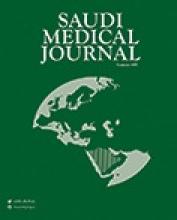Abstract
OBJECTIVE: The purpose of this study is to review the outcome of fracture femur in elderly patients (>65 years), and to identify cause or causes of mortality.
METHODS: Between January 1996 and December 2002, 115 patients over 65 years were admitted and operated at King Fahd University Hospital, Al-Khobar. Fifty-six of patients suffered with femoral fractures. Demographic data collected included age, gender, site of fracture, co-morbidities, delay in surgery, duration of surgery, implant used and Anesthesia Society of America scoring (ASA). A minimum follow up of 12 months was considered important for inclusion in the study. Patients remained alive were assessed for their functional independence.
RESULTS: The data of 48 patients were gathered for analysis. There were 31 males and 17 females with a mean age of 76.5 years (age range 65-101 years). The mean follow up was 32.8 months (12-84 months ± SD 17.81). There were 32 fractures of the trochanteric area. The average delay in surgery was 112 hours (24-280 hours). At the end of 24 months: 13 (27%) were dead and 28 (80%) were functionally independent similar to pre-injury status. There was statistical significance between the ASA score and the mortality (p<0.005). However, mortality significantly higher in patients who underwent surgery under general anesthesia p<0.05.
CONCLUSION: Our data indicate that the mortality in the elderly is not related to the delay in surgery. The significant factors to early demise of patients were high ASA score, and the type of anesthesia used during surgery.
- Copyright: © Saudi Medical Journal
This is an open-access article distributed under the terms of the Creative Commons Attribution-Noncommercial License (CC BY-NC), which permits unrestricted use, distribution, and reproduction in any medium, provided the original work is properly cited.






